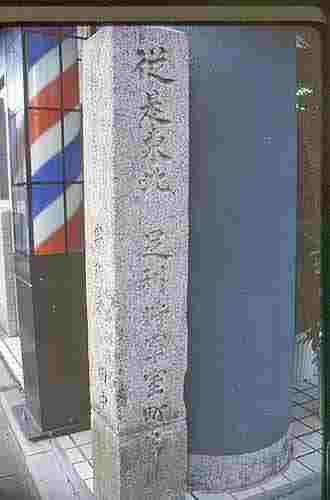Muromachi Street on:
[Wikipedia]
[Google]
[Amazon]
 is a street in
is a street in 
 In 1378, near where Imadegawa Street now intersects Muromachi Street (),Specifically, at the block now bounded by Karasuma Street, Imadegawa Street and Kamitachiuri Street. the third ''
In 1378, near where Imadegawa Street now intersects Muromachi Street (),Specifically, at the block now bounded by Karasuma Street, Imadegawa Street and Kamitachiuri Street. the third ''
 is a street in
is a street in Kyoto
Kyoto (; Japanese: , ''Kyōto'' ), officially , is the capital city of Kyoto Prefecture in Japan. Located in the Kansai region on the island of Honshu, Kyoto forms a part of the Keihanshin metropolitan area along with Osaka and Kobe. , the c ...
, Japan
Japan ( ja, 日本, or , and formally , ''Nihonkoku'') is an island country in East Asia. It is situated in the northwest Pacific Ocean, and is bordered on the west by the Sea of Japan, while extending from the Sea of Okhotsk in the n ...
. Originally a path called in Heian-kyō
Heian-kyō was one of several former names for the city now known as Kyoto. It was the official capital of Japan for over one thousand years, from 794 to 1868 with an interruption in 1180.
Emperor Kanmu established it as the capital in 794, mov ...
, the ancient capital that preceded Kyoto, it lies to the west of and runs north-south from in Kita-ku to in Minami-ku. En route, it is blocked by Higashi Hongan-ji Temple and Kyoto Station
Kyoto (; Japanese: , ''Kyōto'' ), officially , is the capital city of Kyoto Prefecture in Japan. Located in the Kansai region on the island of Honshu, Kyoto forms a part of the Keihanshin metropolitan area along with Osaka and Kobe. , the c ...
.

 In 1378, near where Imadegawa Street now intersects Muromachi Street (),Specifically, at the block now bounded by Karasuma Street, Imadegawa Street and Kamitachiuri Street. the third ''
In 1378, near where Imadegawa Street now intersects Muromachi Street (),Specifically, at the block now bounded by Karasuma Street, Imadegawa Street and Kamitachiuri Street. the third ''shōgun
, officially , was the title of the military dictators of Japan during most of the period spanning from 1185 to 1868. Nominally appointed by the Emperor, shoguns were usually the de facto rulers of the country, though during part of the Kamaku ...
'' Ashikaga Yoshimitsu
was the third '' shōgun'' of the Ashikaga shogunate, ruling from 1368 to 1394 during the Muromachi period of Japan. Yoshimitsu was Ashikaga Yoshiakira's third son but the oldest son to survive, his childhood name being Haruō (). Yoshimitsu ...
established the , a luxurious palace that became the political and cultural center of the country. Today, its location is commemorated by a stone marker in what was its southwestern corner and relics from excavations in the area are held in the of Dōshisha University. The Ashikaga (Muromachi) shogunate prospered until the Ōnin War
The , also known as the Upheaval of Ōnin and Ōnin-Bunmei war, was a civil war that lasted from 1467 to 1477, during the Muromachi period in Japan. '' Ōnin'' refers to the Japanese era during which the war started; the war ended during the Bun ...
(1467–1477), during which Kyoto disintegrated into the two areas Kamigyō and Shimogyō. After the war, Muromachi Street was the only road between them.
During the Edo period
The or is the period between 1603 and 1867 in the history of Japan, when Japan was under the rule of the Tokugawa shogunate and the country's 300 regional '' daimyo''. Emerging from the chaos of the Sengoku period, the Edo period was character ...
, Muromachi Street saw the growth of kimono
The is a traditional Japanese garment and the national dress of Japan. The kimono is a wrapped-front garment with square sleeves and a rectangular body, and is worn left side wrapped over right, unless the wearer is deceased. The kimono ...
wholesalers, some of which survive today. Each July, districts centered on the intersection between Muromachi Street and Shijō Street () in Shimogyō build floats () to parade during the Gion Matsuri
The is one of the largest and most famous festivals in Japan, taking place annually during the month of July in Kyoto. Many events take place in central Kyoto and at the Yasaka Shrine, the festival's patron shrine, located in Kyoto's famous Gio ...
festival.
Establishments
See also
* :ja:京都市内の通りNotes
{{reflist, group="n" Streets in Kyoto